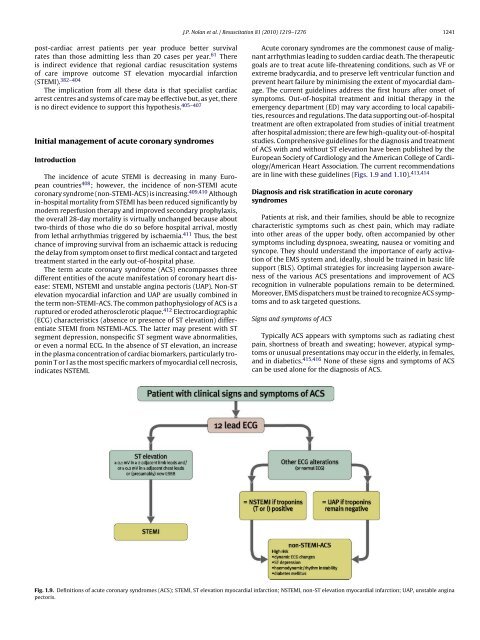European Resuscitation Council Guidelines for Resuscitation 2010 ...
European Resuscitation Council Guidelines for Resuscitation 2010 ...
European Resuscitation Council Guidelines for Resuscitation 2010 ...
You also want an ePaper? Increase the reach of your titles
YUMPU automatically turns print PDFs into web optimized ePapers that Google loves.
J.P. Nolan et al. / <strong>Resuscitation</strong> 81 (<strong>2010</strong>) 1219–1276 1241<br />
post-cardiac arrest patients per year produce better survival<br />
rates than those admitting less than 20 cases per year. 61 There<br />
is indirect evidence that regional cardiac resuscitation systems<br />
of care improve outcome ST elevation myocardial infarction<br />
(STEMI). 382–404<br />
The implication from all these data is that specialist cardiac<br />
arrest centres and systems of care may be effective but, as yet, there<br />
is no direct evidence to support this hypothesis. 405–407<br />
Initial management of acute coronary syndromes<br />
Introduction<br />
The incidence of acute STEMI is decreasing in many <strong>European</strong><br />
countries 408 ; however, the incidence of non-STEMI acute<br />
coronary syndrome (non-STEMI-ACS) is increasing. 409,410 Although<br />
in-hospital mortality from STEMI has been reduced significantly by<br />
modern reperfusion therapy and improved secondary prophylaxis,<br />
the overall 28-day mortality is virtually unchanged because about<br />
two-thirds of those who die do so be<strong>for</strong>e hospital arrival, mostly<br />
from lethal arrhythmias triggered by ischaemia. 411 Thus, the best<br />
chance of improving survival from an ischaemic attack is reducing<br />
the delay from symptom onset to first medical contact and targeted<br />
treatment started in the early out-of-hospital phase.<br />
The term acute coronary syndrome (ACS) encompasses three<br />
different entities of the acute manifestation of coronary heart disease:<br />
STEMI, NSTEMI and unstable angina pectoris (UAP). Non-ST<br />
elevation myocardial infarction and UAP are usually combined in<br />
the term non-STEMI-ACS. The common pathophysiology of ACS is a<br />
ruptured or eroded atherosclerotic plaque. 412 Electrocardiographic<br />
(ECG) characteristics (absence or presence of ST elevation) differentiate<br />
STEMI from NSTEMI-ACS. The latter may present with ST<br />
segment depression, nonspecific ST segment wave abnormalities,<br />
or even a normal ECG. In the absence of ST elevation, an increase<br />
in the plasma concentration of cardiac biomarkers, particularly troponin<br />
T or I as the most specific markers of myocardial cell necrosis,<br />
indicates NSTEMI.<br />
Acute coronary syndromes are the commonest cause of malignant<br />
arrhythmias leading to sudden cardiac death. The therapeutic<br />
goals are to treat acute life-threatening conditions, such as VF or<br />
extreme bradycardia, and to preserve left ventricular function and<br />
prevent heart failure by minimising the extent of myocardial damage.<br />
The current guidelines address the first hours after onset of<br />
symptoms. Out-of-hospital treatment and initial therapy in the<br />
emergency department (ED) may vary according to local capabilities,<br />
resources and regulations. The data supporting out-of-hospital<br />
treatment are often extrapolated from studies of initial treatment<br />
after hospital admission; there are few high-quality out-of-hospital<br />
studies. Comprehensive guidelines <strong>for</strong> the diagnosis and treatment<br />
of ACS with and without ST elevation have been published by the<br />
<strong>European</strong> Society of Cardiology and the American College of Cardiology/American<br />
Heart Association. The current recommendations<br />
are in line with these guidelines (Figs. 1.9 and 1.10). 413,414<br />
Diagnosis and risk stratification in acute coronary<br />
syndromes<br />
Patients at risk, and their families, should be able to recognize<br />
characteristic symptoms such as chest pain, which may radiate<br />
into other areas of the upper body, often accompanied by other<br />
symptoms including dyspnoea, sweating, nausea or vomiting and<br />
syncope. They should understand the importance of early activation<br />
of the EMS system and, ideally, should be trained in basic life<br />
support (BLS). Optimal strategies <strong>for</strong> increasing layperson awareness<br />
of the various ACS presentations and improvement of ACS<br />
recognition in vulnerable populations remain to be determined.<br />
Moreover, EMS dispatchers must be trained to recognize ACS symptoms<br />
and to ask targeted questions.<br />
Signs and symptoms of ACS<br />
Typically ACS appears with symptoms such as radiating chest<br />
pain, shortness of breath and sweating; however, atypical symptoms<br />
or unusual presentations may occur in the elderly, in females,<br />
and in diabetics. 415,416 None of these signs and symptoms of ACS<br />
can be used alone <strong>for</strong> the diagnosis of ACS.<br />
Fig. 1.9. Definitions of acute coronary syndromes (ACS); STEMI, ST elevation myocardial infarction; NSTEMI, non-ST elevation myocardial infarction; UAP, unstable angina<br />
pectoris.
















